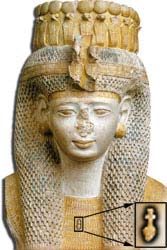
Nefer
(nefer)
Appearance: The origin of the hieroglyph is complex. It's appearance is sometimes described as a stylized stomach and windpipe. However, the hieroglyph is actually the heart and trachea. It originally may have been the esophagus and heart. The striations of the windpipe only appear in the hieroglyph following the Old Kingdom. The lower part of the sign has always clearly been the heart, for the markings clearly follow the form of a sheep's heart.
Meaning: The term nefer was very popular throughout the ages with the ancient Egyptians. It appears with a dozen different meanings in their literature... all positive. It was also incorporated into many personal names, including those of the famous queens Nefertiti and Nefertari.
The nefer hieroglyph was used to convey the concepts of "goodness" and "beauty". This is poignantly illustrated in the statue to the right of Merytamun, the daughter of Rameses II. Her necklace is nothing but rows and rows of the 'nefer' hieroglyph. It also could carry the meaning of happiness, good fortune, youth and other related ideas. The sign was used in amulets and other decorative jewelry. Vases were also sometimes produced in the shape of the hieroglyph.
The White Crown of Upper Egypt was sometimes called "the Nefer" or "the White Nefer."
Digg This!
![]() Del.icio.us
Del.icio.us
![]() Stumble Upon
Stumble Upon
